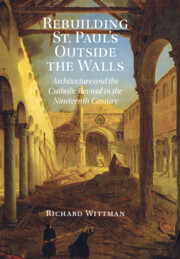Book contents
Introduction
Published online by Cambridge University Press: 11 January 2024
Summary
Paul of Tarsus – St. Paul the Apostle, the Apostle to the Gentiles, God’s Chosen Vessel – was martyred in Rome sometime between 65 and 67 CE. He was laid to rest along the via Ostiense, south of Rome, in a sepulchral area owned by a Christian woman named Lucina, where his tomb soon attracted great veneration. Not long after Emperor Constantine accepted Christianity in 313, a modest basilica was erected to shelter the tomb, sponsored, probably, by Constantine himself. Within a few decades, local devotion had outgrown this first basilica, so in 384 (or 386) the co-emperors Theodosius I, Valentinian II, and Arcadius launched the construction of a far bigger one. This prodigious new monument was consecrated under Honorius early in the fifth century and came to be known as San Paolo fuori le mura for its location beyond the old Aurelian city walls. It was to endure for more than fourteen centuries as one of the most important churches in Christendom and, with St. Peter’s, one of Rome’s two most important pilgrimage centers2 (Figure 1).
- Type
- Chapter
- Information
- Rebuilding St. Paul's Outside the WallsArchitecture and the Catholic Revival in the 19th Century, pp. 1 - 10Publisher: Cambridge University PressPrint publication year: 2024

